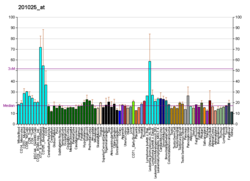Function
eIF5B plays an important role in later stages of the translation initiation mechanism. After the start codon has been engaged by the scanning initiation complex, eukaryotic initiation factors eIF1, eIF2, and eIF5 leave the ribosome. Subsequently, eIF5B-GTP is recruited to the ribosome. eIF1A induces rotation of a domain of eIF5B-GTP, which in turn positions the initiator tRNA such that joining of the large ribosomal subunit is possible. [9] Joining of the large subunit causes hydrolysis of the eIF5B-bound GTP, which accelerates the release of eIF1A from the ribosome. [10] Dissociation of eIF1A leads to another rearrangement of eIF5B, placing the initiator tRNA in its final position. [11] The hydrolysis of eIF5B's GTP reduces its affinity to the ribosome, ultimately leading to its dissociation. This concludes the initiation of translation.
This page is based on this
Wikipedia article Text is available under the
CC BY-SA 4.0 license; additional terms may apply.
Images, videos and audio are available under their respective licenses.






